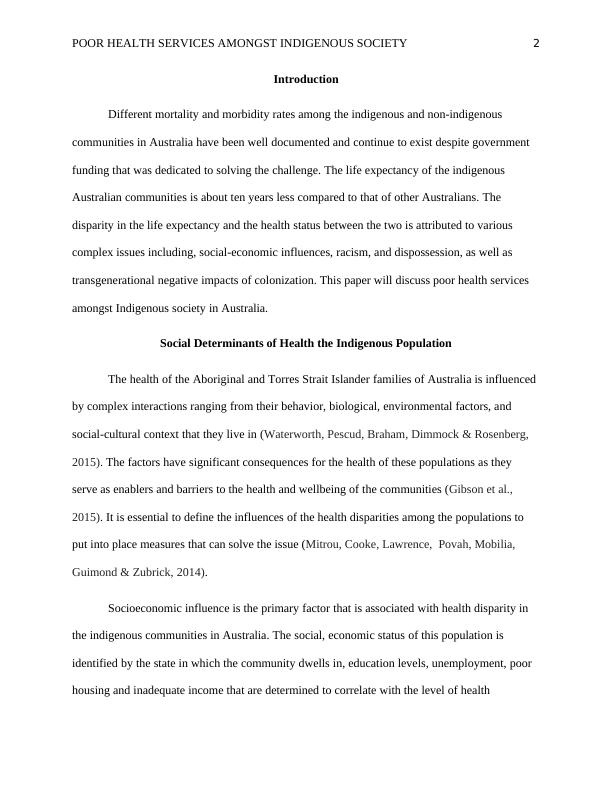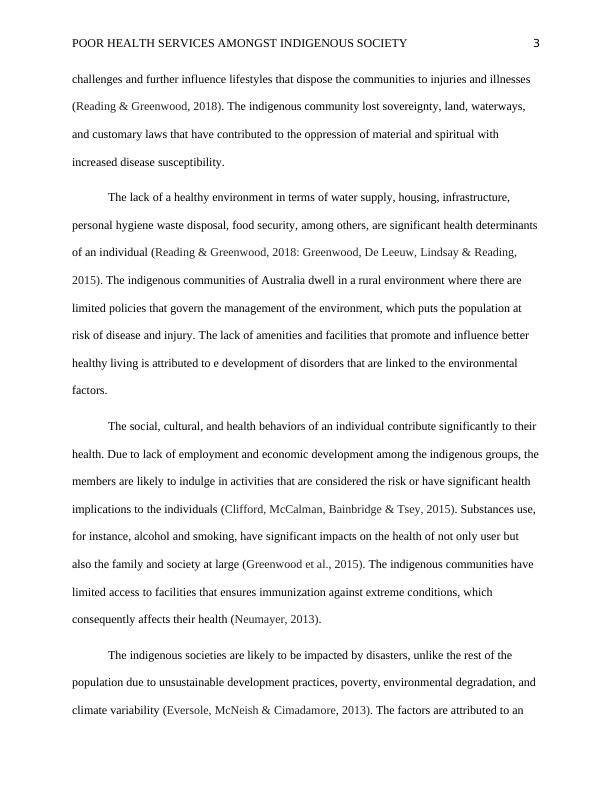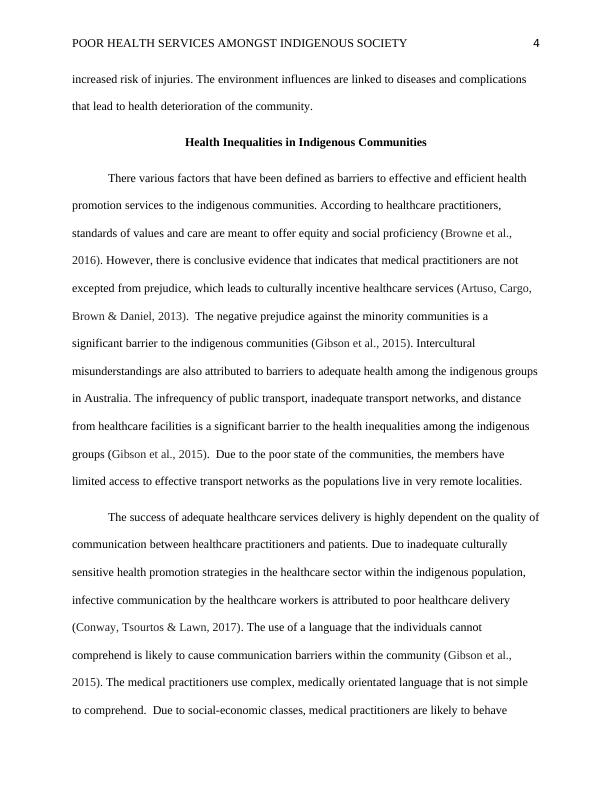POOR HEALTH SERVICES AMONGST INDIGENOUS SOCIETY.
Added on 2022-10-04
17 Pages4588 Words15 Views
Running head: POOR HEALTH SERVICES AMONGST INDIGENOUS SOCIETY 1
Poor Health Services Amongst Indigenous Society
Students Name
Institution Affiliation
Poor Health Services Amongst Indigenous Society
Students Name
Institution Affiliation

POOR HEALTH SERVICES AMONGST INDIGENOUS SOCIETY 2
Introduction
Different mortality and morbidity rates among the indigenous and non-indigenous
communities in Australia have been well documented and continue to exist despite government
funding that was dedicated to solving the challenge. The life expectancy of the indigenous
Australian communities is about ten years less compared to that of other Australians. The
disparity in the life expectancy and the health status between the two is attributed to various
complex issues including, social-economic influences, racism, and dispossession, as well as
transgenerational negative impacts of colonization. This paper will discuss poor health services
amongst Indigenous society in Australia.
Social Determinants of Health the Indigenous Population
The health of the Aboriginal and Torres Strait Islander families of Australia is influenced
by complex interactions ranging from their behavior, biological, environmental factors, and
social-cultural context that they live in (Waterworth, Pescud, Braham, Dimmock & Rosenberg,
2015). The factors have significant consequences for the health of these populations as they
serve as enablers and barriers to the health and wellbeing of the communities (Gibson et al.,
2015). It is essential to define the influences of the health disparities among the populations to
put into place measures that can solve the issue (Mitrou, Cooke, Lawrence, Povah, Mobilia,
Guimond & Zubrick, 2014).
Socioeconomic influence is the primary factor that is associated with health disparity in
the indigenous communities in Australia. The social, economic status of this population is
identified by the state in which the community dwells in, education levels, unemployment, poor
housing and inadequate income that are determined to correlate with the level of health
Introduction
Different mortality and morbidity rates among the indigenous and non-indigenous
communities in Australia have been well documented and continue to exist despite government
funding that was dedicated to solving the challenge. The life expectancy of the indigenous
Australian communities is about ten years less compared to that of other Australians. The
disparity in the life expectancy and the health status between the two is attributed to various
complex issues including, social-economic influences, racism, and dispossession, as well as
transgenerational negative impacts of colonization. This paper will discuss poor health services
amongst Indigenous society in Australia.
Social Determinants of Health the Indigenous Population
The health of the Aboriginal and Torres Strait Islander families of Australia is influenced
by complex interactions ranging from their behavior, biological, environmental factors, and
social-cultural context that they live in (Waterworth, Pescud, Braham, Dimmock & Rosenberg,
2015). The factors have significant consequences for the health of these populations as they
serve as enablers and barriers to the health and wellbeing of the communities (Gibson et al.,
2015). It is essential to define the influences of the health disparities among the populations to
put into place measures that can solve the issue (Mitrou, Cooke, Lawrence, Povah, Mobilia,
Guimond & Zubrick, 2014).
Socioeconomic influence is the primary factor that is associated with health disparity in
the indigenous communities in Australia. The social, economic status of this population is
identified by the state in which the community dwells in, education levels, unemployment, poor
housing and inadequate income that are determined to correlate with the level of health

POOR HEALTH SERVICES AMONGST INDIGENOUS SOCIETY 3
challenges and further influence lifestyles that dispose the communities to injuries and illnesses
(Reading & Greenwood, 2018). The indigenous community lost sovereignty, land, waterways,
and customary laws that have contributed to the oppression of material and spiritual with
increased disease susceptibility.
The lack of a healthy environment in terms of water supply, housing, infrastructure,
personal hygiene waste disposal, food security, among others, are significant health determinants
of an individual (Reading & Greenwood, 2018: Greenwood, De Leeuw, Lindsay & Reading,
2015). The indigenous communities of Australia dwell in a rural environment where there are
limited policies that govern the management of the environment, which puts the population at
risk of disease and injury. The lack of amenities and facilities that promote and influence better
healthy living is attributed to e development of disorders that are linked to the environmental
factors.
The social, cultural, and health behaviors of an individual contribute significantly to their
health. Due to lack of employment and economic development among the indigenous groups, the
members are likely to indulge in activities that are considered the risk or have significant health
implications to the individuals (Clifford, McCalman, Bainbridge & Tsey, 2015). Substances use,
for instance, alcohol and smoking, have significant impacts on the health of not only user but
also the family and society at large (Greenwood et al., 2015). The indigenous communities have
limited access to facilities that ensures immunization against extreme conditions, which
consequently affects their health (Neumayer, 2013).
The indigenous societies are likely to be impacted by disasters, unlike the rest of the
population due to unsustainable development practices, poverty, environmental degradation, and
climate variability (Eversole, McNeish & Cimadamore, 2013). The factors are attributed to an
challenges and further influence lifestyles that dispose the communities to injuries and illnesses
(Reading & Greenwood, 2018). The indigenous community lost sovereignty, land, waterways,
and customary laws that have contributed to the oppression of material and spiritual with
increased disease susceptibility.
The lack of a healthy environment in terms of water supply, housing, infrastructure,
personal hygiene waste disposal, food security, among others, are significant health determinants
of an individual (Reading & Greenwood, 2018: Greenwood, De Leeuw, Lindsay & Reading,
2015). The indigenous communities of Australia dwell in a rural environment where there are
limited policies that govern the management of the environment, which puts the population at
risk of disease and injury. The lack of amenities and facilities that promote and influence better
healthy living is attributed to e development of disorders that are linked to the environmental
factors.
The social, cultural, and health behaviors of an individual contribute significantly to their
health. Due to lack of employment and economic development among the indigenous groups, the
members are likely to indulge in activities that are considered the risk or have significant health
implications to the individuals (Clifford, McCalman, Bainbridge & Tsey, 2015). Substances use,
for instance, alcohol and smoking, have significant impacts on the health of not only user but
also the family and society at large (Greenwood et al., 2015). The indigenous communities have
limited access to facilities that ensures immunization against extreme conditions, which
consequently affects their health (Neumayer, 2013).
The indigenous societies are likely to be impacted by disasters, unlike the rest of the
population due to unsustainable development practices, poverty, environmental degradation, and
climate variability (Eversole, McNeish & Cimadamore, 2013). The factors are attributed to an

POOR HEALTH SERVICES AMONGST INDIGENOUS SOCIETY 4
increased risk of injuries. The environment influences are linked to diseases and complications
that lead to health deterioration of the community.
Health Inequalities in Indigenous Communities
There various factors that have been defined as barriers to effective and efficient health
promotion services to the indigenous communities. According to healthcare practitioners,
standards of values and care are meant to offer equity and social proficiency (Browne et al.,
2016). However, there is conclusive evidence that indicates that medical practitioners are not
excepted from prejudice, which leads to culturally incentive healthcare services (Artuso, Cargo,
Brown & Daniel, 2013). The negative prejudice against the minority communities is a
significant barrier to the indigenous communities (Gibson et al., 2015). Intercultural
misunderstandings are also attributed to barriers to adequate health among the indigenous groups
in Australia. The infrequency of public transport, inadequate transport networks, and distance
from healthcare facilities is a significant barrier to the health inequalities among the indigenous
groups (Gibson et al., 2015). Due to the poor state of the communities, the members have
limited access to effective transport networks as the populations live in very remote localities.
The success of adequate healthcare services delivery is highly dependent on the quality of
communication between healthcare practitioners and patients. Due to inadequate culturally
sensitive health promotion strategies in the healthcare sector within the indigenous population,
infective communication by the healthcare workers is attributed to poor healthcare delivery
(Conway, Tsourtos & Lawn, 2017). The use of a language that the individuals cannot
comprehend is likely to cause communication barriers within the community (Gibson et al.,
2015). The medical practitioners use complex, medically orientated language that is not simple
to comprehend. Due to social-economic classes, medical practitioners are likely to behave
increased risk of injuries. The environment influences are linked to diseases and complications
that lead to health deterioration of the community.
Health Inequalities in Indigenous Communities
There various factors that have been defined as barriers to effective and efficient health
promotion services to the indigenous communities. According to healthcare practitioners,
standards of values and care are meant to offer equity and social proficiency (Browne et al.,
2016). However, there is conclusive evidence that indicates that medical practitioners are not
excepted from prejudice, which leads to culturally incentive healthcare services (Artuso, Cargo,
Brown & Daniel, 2013). The negative prejudice against the minority communities is a
significant barrier to the indigenous communities (Gibson et al., 2015). Intercultural
misunderstandings are also attributed to barriers to adequate health among the indigenous groups
in Australia. The infrequency of public transport, inadequate transport networks, and distance
from healthcare facilities is a significant barrier to the health inequalities among the indigenous
groups (Gibson et al., 2015). Due to the poor state of the communities, the members have
limited access to effective transport networks as the populations live in very remote localities.
The success of adequate healthcare services delivery is highly dependent on the quality of
communication between healthcare practitioners and patients. Due to inadequate culturally
sensitive health promotion strategies in the healthcare sector within the indigenous population,
infective communication by the healthcare workers is attributed to poor healthcare delivery
(Conway, Tsourtos & Lawn, 2017). The use of a language that the individuals cannot
comprehend is likely to cause communication barriers within the community (Gibson et al.,
2015). The medical practitioners use complex, medically orientated language that is not simple
to comprehend. Due to social-economic classes, medical practitioners are likely to behave

End of preview
Want to access all the pages? Upload your documents or become a member.
Related Documents
Risk of Disease among Indigenous of Remote Areas Australia Report 2022lg...
|13
|3660
|21
Health Disparities in the Indigenous Community Name of the Student Name of the University Author Note Introductionlg...
|5
|1076
|385
Health Disparities in Indigenous Peoplelg...
|5
|1226
|26
Health Disparity in Indigenous and Non-Indigenous People in Australialg...
|9
|2428
|92
Amata population within the Indigenous community resididilg...
|6
|1296
|50
Determinants of Health Discrepancies in Australialg...
|11
|3022
|456
